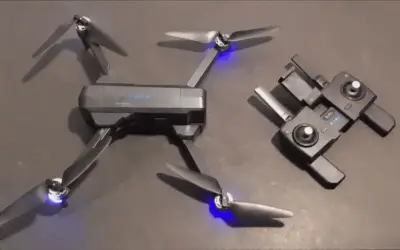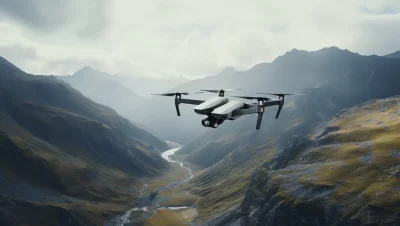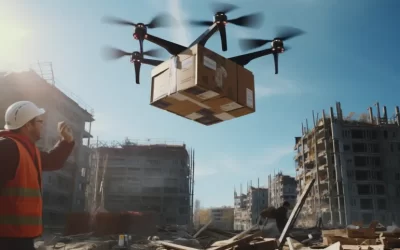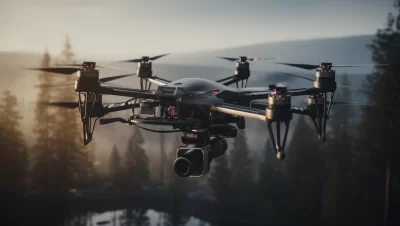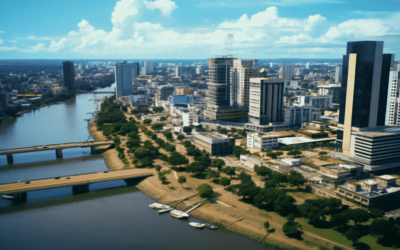Hey there, fellow drone enthusiasts or someone just curious about drone regulations in Sri Lanka! I totally get it—drones are an incredible technology, but navigating the legal side of things can be a bit perplexing.
Whether you’re a drone pilot or simply looking for information, you’ve come to the right place. Sri Lanka’s drone laws can sometimes seem like a labyrinth, but I’m here to shed some light and make it all crystal clear for you.
So, here’s the deal: I’ve dived deep into the world of Sri Lanka’s drone laws. You see, I’m passionate about drones, and I’ve done my homework to understand the nitty-gritty of the regulations.
From the registration process to no-fly zones and altitude restrictions, I’ve got the answers you’re seeking. I’ve sifted through official documents and contacted experts to ensure you’re getting the most accurate and up-to-date information.
If you’re wondering how to legally take your drone to the skies in Sri Lanka or are just curious about the rules in place, keep reading. My article is your roadmap to understanding Sri Lanka’s drone laws.
I promise you a comprehensive guide that will not only make you drone-savvy but also ensure you’re on the right side of the law. So, let’s get started, and I’ll walk you through the fascinating world of Sri Lanka’s drone regulations.
- Background on Drone Usage in Sri Lanka
- Regulatory Authority in Sri Lanka
- Sri Lanka Drone Registration
- Sri Lanka Flight Permissions
- No-Fly Zones in Sri Lanka
- Sri Lanka Altitude Restrictions
- Safety and Privacy Considerations in Sri Lanka
- Sri Lanka Remote Identification
- Sri Lanka Penalties and Enforcement
- Final Thoughts on Sri Lanka Drone Laws
- Frequently Asked Questions
Background on Drone Usage in Sri Lanka

Alright, let’s step back a bit and take a look at how drones have been making their mark in the tropical paradise of Sri Lanka. It’s a fascinating journey that’s been shaping not just the skies but a whole lot more.
Drone technology and its various applications in Sri Lanka
You won’t believe how drones have swooped into Sri Lanka, transforming sci-fi dreams into buzzing realities. These sleek, futuristic machines have found a cozy spot in a variety of sectors. From agriculture to wildlife conservation, the Sri Lankan drone scene is brimming with innovation.
Picture this: drones soaring over lush tea plantations, helping farmers monitor crops and manage resources more efficiently.
Those breathtaking aerial shots of Sri Lanka’s pristine beaches and ancient temples? Yep, often captured by drone enthusiasts and professional videographers. It’s not just about stunning visuals, though.
Drones are playing a crucial role in environmental protection, surveying fragile ecosystems, and aiding wildlife conservation efforts.
And let’s not forget about disaster management. Sri Lanka, like many other places, faces natural calamities. Drones, with their swift aerial surveillance capabilities, have become indispensable tools for assessing damage and guiding relief efforts in the aftermath of disasters.
Regulatory measures due to the increasing number of drones in the country
As drones weave their magic in various fields, it’s only natural that their numbers are on the rise. With more drones taking flight, the need for clear-cut regulations becomes evident. This isn’t about stifling innovation; it’s about ensuring responsible and safe drone use.
With so many drones in the sky, ensuring air traffic safety and privacy protection becomes paramount. Think about it: drones zipping around without any rules would be chaotic, not to mention potentially hazardous.
By establishing guidelines and rules, the authorities aim to strike a balance between enabling drone enthusiasts to pursue their passions and safeguarding public interests.
So, in the midst of all this drone-powered excitement, Sri Lanka has put in place regulations to keep things in check.
The question now is, what exactly are these rules, and how do they impact drone enthusiasts and operators? We’ll dig deep into these Sri Lanka drone laws shortly, so keep reading to stay informed and fly your drone responsibly.
Also Read: Spain Drone Regulation 2024
Regulatory Authority in Sri Lanka

Now, let’s talk about the puppeteers behind the scenes—the ones who make sure the drone show runs smoothly in Sri Lanka. The Civil Aviation Authority of Sri Lanka (CAASL) takes the lead here, and their role is pretty crucial.
Civil Aviation Authority of Sri Lanka (CAASL)
Meet the CAASL, your go-to authority when it comes to drone matters in Sri Lanka. These folks are the real deal; they’re tasked with overseeing and regulating all things related to aviation, including the rapidly growing drone sector.
Think of them as the traffic cops of the skies, making sure drones don’t bump into each other or anything else up there.
But what sets the CAASL apart from the rest is their dedication to keeping the drone space organized. They don’t just stop at issuing permits and regulations; they’re all about ensuring safety, security, and adherence to the rules. So, if you’re planning to fly your drone in Sri Lanka, you’re going to want to be on their good side.
Role and responsibilities of the CAASL in regulating drone activities
The CAASL isn’t just about red tape and paperwork. They’ve got a serious mission. It’s their job to craft the rules, grant the permissions, and ensure that drone operations in Sri Lanka don’t go haywire.
They’re the ones defining no-fly zones, setting altitude restrictions, and making sure operators play by the book.
This isn’t just about imposing rules for the sake of it; it’s about fostering a safe and responsible drone culture. They’ve got a watchful eye over the drone community, and their dedication to keeping the skies harmonious is commendable.
If you’re a drone enthusiast or operator, understanding the CAASL’s role is key to a smooth flight in Sri Lanka. Stick around, and we’ll dive even deeper into the intricacies of their regulations.
Also Read: South Africa Drone Regulation 2024
Sri Lanka Drone Registration

Now, let’s talk about getting your drone officially on the books. In Sri Lanka, it’s not just about getting a drone; it’s about getting it registered with the CAASL. This is where the journey to becoming a responsible drone operator begins.
The process of registering drones with the CAASL
So, you’ve got your hands on a sleek drone, and you’re itching to take it to the skies. The first step? Registration. It’s not as daunting as it sounds, but it’s essential.
The CAASL has made it relatively straightforward. You’ll need to provide some basic information about yourself and your drone, like its make, model, and specifications.
Once you’ve gathered all the necessary documents and data, you submit your application to the CAASL. They’ll review it and grant you the green light to operate your drone legally.
The required documentation and fees for registration
Of course, no government process is complete without a little paperwork and some fees, right? Don’t worry; it’s not too complicated. You’ll need to provide proof of identification, the drone’s details, and some information about your flying experience.
As for the fees, they’re usually quite reasonable, considering it’s a one-time thing. But keep in mind that the exact requirements and costs might vary, so it’s a good idea to check with the CAASL for the latest information.
The significance of registering drones to ensure accountability and tracking
Why is all this registration necessary? Well, it’s not just bureaucracy for the sake of it. Registering your drone ensures accountability and tracking. In the unlikely event that your drone goes rogue or causes any issues, authorities can trace it back to you, the responsible operator.
This transparency is crucial for maintaining safety in the skies and safeguarding privacy on the ground. It’s a way of ensuring that drone enthusiasts and operators can continue to enjoy their hobby while respecting the rules and the rights of others.
So, if you’ve got a drone, make sure it’s officially in the books. It’s for the greater good of the drone community in Sri Lanka.
Also Read: Somalia Drone Regulation 2024
Sri Lanka Flight Permissions

Now, we’re venturing into the skies – or at least, we’re about to, but not without the right permissions.
In Sri Lanka, flying your drone legally involves a bit of paperwork and a lot of responsibility. Let’s get into the details.
Obtaining flight permissions before operating a drone in Sri Lanka
If you’re thinking of firing up those propellers and launching your drone into the skies of Sri Lanka without a care in the world, think again. Flight permissions are a non-negotiable requirement here.
This isn’t about curbing your enthusiasm; it’s about ensuring the safety of everyone and everything in the airspace. Obtaining these permissions is your ticket to lawful drone adventures, and it’s a vital step to take.
The application process for obtaining flight permissions from the CAASL
Now, how exactly do you go about securing these flight permissions? Well, it’s a well-structured process. You’ll need to submit an application to the CAASL.
It should outline the specifics of your drone operation, including the location, date, and purpose of the flight.
The CAASL will carefully review your request to ensure it complies with their rules and safety regulations.
If your application gets the green light, you’re good to go. The key here is to plan your drone adventures ahead and make sure you’re adhering to the guidelines set by the authority.
The importance of adhering to the rules and regulations while flying drones
The rules and regulations set by the CAASL aren’t just suggestions; they’re crucial for ensuring the harmonious coexistence of drones and other aerial activities.
Flying safely means flying responsibly. When you’re up there in the skies, it’s essential to adhere to the height restrictions, no-fly zones, and any other specific guidelines.
This isn’t about putting a damper on your drone fun; it’s about making sure everyone’s experience, on the ground and in the air, is a positive one.
So, while the freedom to fly your drone is exciting, let’s remember that with great power comes great responsibility.
Also Read: Solomon Islands Drone Regulation 2024
No-Fly Zones in Sri Lanka

Alright, folks, fasten your seatbelts, because we’re entering a territory where drones are a big no-no. These are the no-fly zones in Sri Lanka, and it’s essential to know where you can’t take your drone.
No-fly zones in Sri Lanka, such as near airports, military bases, and government buildings
No-fly zones are like the red lights on a traffic signal, and you definitely don’t want to run them. In Sri Lanka, there are specific areas where drones simply can’t roam.
This includes airspace around airports, military bases, and government buildings. These places have extra layers of security, and for good reason.
Flying drones near them could pose risks and potentially lead to security concerns, so it’s a strict no-go.
Prohibition of drone flights in these sensitive areas
Let’s be clear about this – when we say no-fly zones, we mean no-fly zones. The authorities take the prohibition in these areas very seriously.
There’s no wiggle room for negotiation here. It’s all about keeping things safe and secure. While we all love our drones and the freedom to fly, respecting these no-fly zones is vital.
It’s not just about following the rules; it’s about respecting the security and safety of everyone in those areas. So, consider this your friendly reminder: no-fly zones are a red line you simply don’t cross.
Also Read: Slovenia Drone Regulation 2024
Sri Lanka Altitude Restrictions

It is time to take our drones to new heights, but not without some guidelines in place. The CAASL has set altitude restrictions to ensure safe and responsible drone operations. Let’s explore what those limits are and why they matter.
Altitude restrictions imposed on drone flights by the CAASL
So, here’s the deal: the CAASL has laid down some specific altitude restrictions for drone flights. They’re not trying to limit your drone’s ascent for fun, but rather for safety.
Generally, the altitude cap is set to ensure that drones don’t interfere with other airspace activities, like manned aircraft.
The exact limits might vary, but it’s crucial to be aware of these boundaries to enjoy your drone safely and responsibly.
Consequences of exceeding altitude limits and the potential penalties involved
What happens if you decide to go maverick and exceed those altitude limits? Well, it’s not a path you’d want to tread.
The consequences can range from fines to more severe penalties, depending on the violation and its impact. But it’s not just about penalties; it’s also about safety.
Going beyond the prescribed altitude can lead to near misses with manned aircraft, which can have catastrophic consequences.
So, when we talk about altitude restrictions, it’s not just about following the rules; it’s about keeping our skies secure and preventing accidents. It’s a win-win for everyone involved.
Also Read: Slovakia Drone Regulation 2024
Safety and Privacy Considerations in Sri Lanka

As we venture further into the drone world, let’s pause for a moment to talk about safety and privacy. Yes, it’s not all about rules and regulations; it’s about being responsible and respectful.
Safety guidelines for drone operators
When it comes to drones, safety is the name of the game. Whether you’re an experienced pilot or just starting out, there are some universal guidelines to follow. For instance, always keep your drone in sight, steer clear of other aircraft, and fly in good weather conditions.
These might sound like no-brainers, but they’re essential to preventing accidents and ensuring public safety.
And speaking from experience, it’s crucial to stay up-to-date with the latest safety practices. After all, we’re all in this together, and a safe flight is a happy flight.
Respecting privacy laws and protecting individuals’ privacy when using drones
Now, here’s a topic that can’t be overlooked – privacy. Drones equipped with cameras can capture some stunning views, but they also have the potential to invade people’s privacy.
It’s crucial to be aware of and respect privacy laws in Sri Lanka. Avoid capturing images or videos of individuals without their consent, and steer clear of restricted areas like private properties.
Think about how you’d feel if a drone was buzzing outside your window; it’s all about that golden rule – do unto others as you’d have them do unto you.
So, as you embark on your drone adventures, remember that responsible and respectful flying is the way to go.
Also Read: Singapore Drone Regulation 2024
Sri Lanka Remote Identification

Now, for a topic that’s evolving faster than your drone’s propellers—remote identification. Things change, and in the world of drone regulations, this is a hot topic.
Since my last knowledge update in September 2021, there might have been new developments. Let’s see what’s up.
Remote identification requirements that may have been introduced since my last knowledge update
Now, I have to admit that I’m not entirely sure about the latest updates regarding remote identification requirements.
Regulations in the drone world are ever-evolving, and new rules could have been introduced. It’s always a good idea to check with the CAASL or official sources for the most up-to-date information.
They might have introduced remote identification requirements to enhance the safety and accountability of drone operations. Staying informed about these changes is essential to being a responsible drone operator.
Remote identification and its implications for drone operators
Remote identification, if introduced, serves a vital purpose. It’s all about making sure that drones can be identified while in flight, which is crucial for safety and security.
This system allows authorities and other airspace users to know who’s operating a drone and how to reach them if necessary.
It’s like having a license plate on your car—it helps everyone stay accountable. For drone operators, it might mean additional equipment or processes to comply with, but it’s all part of the responsibility that comes with the freedom to fly. Stay tuned for the latest on this front as the drone landscape continues to evolve.
Also Read: Sierra Leone Drone Regulation 2024
Sri Lanka Penalties and Enforcement

So, you’ve got the lowdown on Sri Lanka’s drone regulations, and you know what’s allowed and what’s not.
But what happens if, intentionally or unintentionally, you step out of line? That’s what we’re diving into—the penalties and the watchful eyes keeping drones in check.
Potential penalties for violating drone regulations in Sri Lanka
Breaking the drone rules isn’t just a slap on the wrist – there are penalties involved. Depending on the nature and severity of the violation, you could face fines, confiscation of your drone, or even legal action.
These penalties are designed to ensure that drone operators stay responsible and adhere to the rules.
After all, the safety and privacy of the public are top priorities, and penalties serve as a deterrent for those who might be tempted to flout the regulations.
Role of law enforcement agencies in monitoring drone activities
Now, how do they catch those who bend or break the rules? That’s where law enforcement agencies come into play. They keep a watchful eye on drone activities.
They may use various means, from on-ground monitoring to advanced technology for tracking drones in the airspace. The aim is to maintain order in the drone world and ensure that everyone plays by the same set of rules.
It’s all about keeping our skies safe and secure, and it’s a collaborative effort between drone operators, the Civil Aviation Authority, and law enforcement agencies.
So, while drones are fun and exciting, it’s crucial to understand that there are eyes in the sky and on the ground to ensure everyone’s safety and well-being.
Also Read: Seychelles Drone Regulation 2024
Final Thoughts on Sri Lanka Drone Laws

And there you have it, my fellow drone enthusiasts and those simply curious about the drone scene in Sri Lanka. We’ve taken quite the journey through the skies and regulations, and now it’s time to wrap things up. Let’s sum it all up and leave you with some parting thoughts.
We’ve covered quite a bit of ground, haven’t we? From the growth of drone technology in Sri Lanka to the role of the Civil Aviation Authority of Sri Lanka (CAASL), and even no-fly zones and altitude restrictions, you’re now well-versed in the world of Sri Lanka’s drone laws. We’ve talked about safety, privacy, and the potential penalties for not playing by the rules. But this is just the beginning of your journey into the fascinating world of drones.
Drones are more than just high-flying toys – they’re a responsibility. Flying a drone is exhilarating, but it comes with duties. Responsible drone operation is not just a legal obligation; it’s a commitment to safety, privacy, and respect for others. By following the regulations set by the CAASL, you not only keep yourself out of trouble but also contribute to a safer and more enjoyable drone environment for everyone.
The drone world is dynamic, and regulations can change. So, as we wrap up, I encourage you to stay informed. Keep an eye on the CAASL’s official channels and announcements for the latest updates. The more you know, the safer and more enjoyable your drone experiences will be. And remember, drones are not just about the thrill of flying; they’re about sharing the skies responsibly and respectfully with fellow aviators. So, keep your propellers spinning, your knowledge growing, and your flights soaring high. Happy droning!
Frequently Asked Questions
1. Do I need to register my drone in Sri Lanka?
Yes, drone registration is a must in Sri Lanka. The Civil Aviation Authority of Sri Lanka (CAASL) requires all drone operators to register their drones to ensure accountability and track drone activity. You’ll need to provide essential information about your drone and yourself to complete the registration process.
2. What are the consequences of violating drone regulations in Sri Lanka?
Violating drone regulations in Sri Lanka can lead to penalties, including fines and the possibility of legal action. The exact penalties depend on the nature and severity of the violation. To enjoy safe and responsible drone flights, it’s crucial to adhere to the regulations set by the CAASL
3. Are there specific areas where drone flights are prohibited in Sri Lanka?
Yes, there are designated no-fly zones in Sri Lanka. These typically include areas around airports, military bases, and government buildings. Drone flights near these sensitive areas are strictly prohibited. Respecting these no-fly zones is not only a legal requirement but also essential for maintaining security and safety.
4. What are the altitude restrictions for drone flights in Sri Lanka?
The CAASL sets altitude restrictions for drone flights to ensure safety and avoid interference with manned aircraft. While the exact limits might vary, it’s vital to be aware of these restrictions. Exceeding altitude limits can lead to penalties and safety risks, including potential near-miss incidents with other aircraft.
5. Is it necessary to obtain flight permissions before operating a drone in Sri Lanka?
Yes, obtaining flight permissions is a prerequisite for drone operations in Sri Lanka. The CAASL has established an application process for obtaining these permissions, which includes providing details about the location, date, and purpose of your drone flight. Adhering to these regulations ensures safety and compliance with the rules set by the authority.


